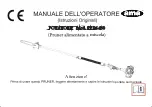
POWX07587
EN
Copyright © 2017 VARO NV
P a g e
|
19
www.varo.com
10.1.3
Bevel cut
Loosen the lever (19) and tilt the saw blade to set the bevel angle (Refer to the previously
covered “Adjusting the bevel angle” 8.4). Be sure to retighten the lever (19) firmly to secure
the selected bevel angle safely. Secure the workpiece against guide fence and turn table.
Switch on the tool without the blade making any contact and wait until the blade attains full
speed. Then gently lower the handle to the fully lowered position while applying pressure in
parallel with the blade. When the cut is completed, switch off the tool and WAIT UNTIL THE
BLADE HAS COME TO A COMPLETE STOP before returning the blade to its fully elevated
position.
CAUTION:
▪
Always be sure that the blade will move down to bevel direction during a bevel cut. Keep
hands out of path of saw blade.
▪
During a bevel cut, it may create a condition whereby the piece cut off will come to rest
against the side of the blade. If the blade is raised while the blade is still rotating, this
piece may be caught by the blade, causing fragments to be scattered which is dangerous.
The blade should be raised ONLY after the blade has come to a complete stop.
▪
When pressing the handle down, apply pressure parallel to the blade. If the pressure is not
parallel to the blade during a cut, the angle of the blade might be shifted and the precision
of the cut will be impaired.
10.1.4
Compound cutting
Compound cutting is the process in which a bevel angle is made at the same time in which a
Mitre angle is being cut on a workpiece. Compound cutting can be performed at angle shown
in the table.
Bevel angle
Miter angle
45°
Left and Right 0
– 45°
When performing compound cutting, refer to “Press cutting”, “Mitre cutting” and “Bevel cut”
explanations.
10.1.5
Cutting aluminum extrusion (Fig. 53)
When securing aluminum extrusions, use spacer blocks or pieces of scrap as shown in the
figure to prevent deformation of the aluminum. Use a cutting lubricant when cutting the
aluminum extrusion to prevent buildup of the aluminum material on the blade.
CAUTION:
▪
Never attempt to cut thick or round aluminum extrusions. Thick aluminum extrusions may
come loose during operation and round aluminum extrusions cannot be secured firmly
with this tool.
▪
Never cut aluminum in the table saw mode (bench mode).
10.2
Cutting as table saw (bench mode)
CAUTION:
▪
Always use “work helpers” such as push sticks and push blocks when there is a danger
that your hands or fingers will come close to the blade.
▪
Always hold the workpiece firmly with the table and the rip fence. Do not bend or twist it
while feeding. If the workpiece is bent or twisted, dangerous kickbacks may occur.
▪
NEVER withdraw the workpiece while the blade is running. If you must withdraw the
workpiece before completing a cut, first switch the tool off while holding the workpiece
firmly. Wait until the blade has come to a complete stop before withdrawing the workpiece.
Failure to do so may cause dangerous kickbacks.
▪
NEVER remove cut-off material while the blade is running.
▪
NEVER place your hands or fingers in the path of the saw blade.
▪
Always secure the rip fence firmly, or dangerous kickbacks may occur.






































